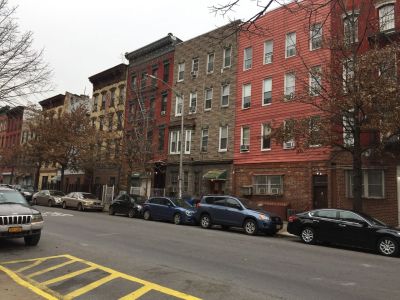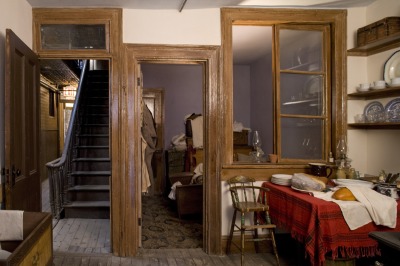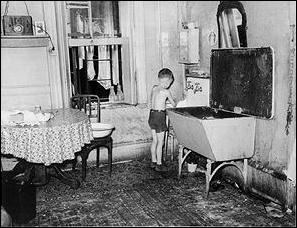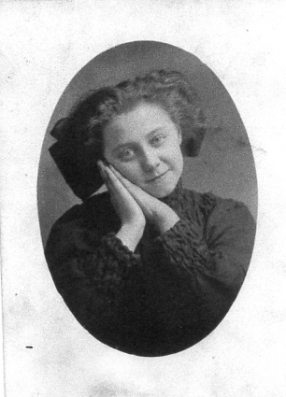 During my ancestor research, I have seen the word “tenement”—with the implication of poverty, filth, and disease–handwritten onto more than one death certificate. Last month, I visited the Lower East Side where my Irish 2x great-grandmother Annie Corliss lived in the tenements near the docks with her husband the Scottish seaman James Inglis and their nine children.
During my ancestor research, I have seen the word “tenement”—with the implication of poverty, filth, and disease–handwritten onto more than one death certificate. Last month, I visited the Lower East Side where my Irish 2x great-grandmother Annie Corliss lived in the tenements near the docks with her husband the Scottish seaman James Inglis and their nine children.
Though the tenements where they lived in the vicinity of Cherry Street a block from the East River have been torn down to build public housing, my newly discovered third cousin Hattie Murphy still lives in the area. She arranged for me to visit the “Irish Outsiders” house in the Tenement Museum on nearby Orchard Street in order to gain an understanding the conditions of life in the tenements in the middle of the nineteenth century.
Tenement housing, which was a euphemism for apartment living in crowded and impoverished conditions, was often built on 25 x 100 foot lots that had been intended for single family homes. These several story buildings with four windows on the front of each floor were divided into small three-room apartments eight to a floor, each with one window facing the street or the back alley.

In the apartment we visited, the window was in the sitting room in the front, the bedroom was in the back, and the kitchen was in the center. The kitchen included a coal stove that was the only heating for the house. Laundry hung above the stove, and, as our guide explained, dirty diapers with only “number one” were simply pinned up to dry. Coal dust hung in the air and fell upon everything. Even in the summer when the windows were open, fresh air rarely reached to the kitchen, let alone to the bedroom in the back. Our guide remarked that the smells of cooking, coal, babies, and unwashed bodies would have been overpowering. Despite their poverty, the women purchased pretty dishes, often chipped, at second hand stores, and proudly displayed them.

Our visit began in the back “garden” where there were four toilets for twenty-two families. I shuddered to imagine trying to clean them or to run down to use them in the middle of the night. There was a pump for fresh water. The guide handed around a bucket filled with pebbles to give us an idea of the weight the housewives and their children had to lug up flights of stairs numerous times each day. No wonder baths were infrequent. I remember an older Greek friend telling me how they used to wash with a cloth from the waist up one day and from the waist down the next. Annie’s family may not even have managed that.

Our tour included a description of a sick and dying baby and a funeral with the baby’s body laid out in the sitting room. My 2x great-grandmother gave birth to nine children of whom, unusually, the first eight lived to adulthood. Annie must have understood that hygiene is heath. Her days would have been spent fighting to keep her house and her children as clean as she could.

The bedroom in the apartment we visited had a small double bed pushed up against two walls, with just enough room to walk past it to get to a small closet and a few trunks crammed in the space against the back wall. When James the seaman was home, this would have been the marital bed, but when he was gone, the younger children slept with their mother, while the older ones wrapped themselves in sheets and blankets near the stove or in the sitting room.

Anne, age 20, and James “Ingles,” mariner, age 25, husband and wife, living in the area of the docks, appear on the 1855 New York State census. In fact, Annie was perhaps 15, while James was 17. I suspected this was an unusually young age to marry, and research proved me right. The average age for Irish marriages at the time was 20 for the bride and 25 for the groom. Annie would have had every reason to lie about her age for reasons of propriety.
Documents I have only recently found show that Ann “Carless,” age 13 arrived in New York with her mother Mary on January 16, 1854. Her two younger brothers, one 7 and the other an infant, died on the ship. As I could not find Ann’s mother Mary after that, I assume she died soon after arriving, leaving her young daughter on her own.
Annie lived her whole life in America in tenements in the the unsavory area near the docks—filled with bars, drunken sailors, prostitution, and crime. She died at the age of forty-five of a stroke, leaving her husband and eight children. Because of her, I am here.
Also see “The Careless Spirit of Annie Corliss.”
***
 Be among the first to order A Serpentine Path, Carol P. Christ’s moving memoir of transformation. Carol’s other new book written with Judith Plaskow is Goddess and God in the World: Conversations in Embodied Theology. Carol also wrote the first Goddess feminist theology, Rebirth of the Goddess.
Be among the first to order A Serpentine Path, Carol P. Christ’s moving memoir of transformation. Carol’s other new book written with Judith Plaskow is Goddess and God in the World: Conversations in Embodied Theology. Carol also wrote the first Goddess feminist theology, Rebirth of the Goddess.
Join Carol on a Goddess Pilgrimage to Crete in 2017. Save $200.
Read two of the chapters in the book: Mysteries and Dionysian Rites.
Thanks to Judith Shaw for the cover art “Downward Serpent.”


wow what a story … I guess my great great grandmother had it a bit easier in outback Australia after all! at least their was fresh air and space – she was married in 1857 out there. … different problems but maybe preferable?
LikeLike
Yes, I too imagine life on the farm was preferable in many ways to life in the tenements. The tenement museum was a real eye-opener. The degree of crowding is hard to picture until you see it in person, and even then, it is sanitized as there are no smells and no inhabitants. Germans and Irish were the first to live in these conditions, followed by Italians and Jews, and more recently, Chinese and Dominicans. The Tenement Museum is a gift to be grateful for.
LikeLiked by 1 person
Hello, Carol. I have been trying to find your books in an ebook format (e.g., for Kindle), but have had no luck. Can you tell us if/when they might be available this way? Is Life in the Tenements a book title? Thank you, Joan
LikeLike
You will find most of my books on kindle on Amazon. There is a link to the ebook of She Who Changes on http://www.goddessariadne.org Carol’s Words.
LikeLiked by 1 person
Hi again, Carol. Have just checked on Amazon, and not finding your books there. You might want to double check the site yourself.
LikeLike
Thanks Carol. Enjoyed this post, love when you write about New York. And I’d like to have that sink you illustrated that can double as a work space!!
In NYC I live in a building constructed 90 years ago. The building itself is part of a huge complex with a total of 1700 apartments and which runs an entire NYC block. When the complex was built it was the largest apartment building in the world. It’s so interesting and so historic it has its own wikipedia.org page — see there listed under “London Terrace.”
LikeLike
New York is so full of history and so many of us and so many of our ancestors have come through it.
LikeLiked by 1 person
Thanks for the link Sarah. I took a peek at http://www.londonterrace.com/apartments. Find it difficult to imagine living in such a large building with so many people.
LikeLike
Hi Barbara Cooper. The population of NYC is approx. 8.4 million, so you constantly mix with lots of people, on the streets, subways, supermarkets, restaurants, in the parks, and usually in your apartment building. But that might be exactly why NYC is so liberal — you get used to a huge diversity and it feels good.
LikeLike
Thanks so much for this evocation of such an important part of our history. When we realize how hard life was for so many of our ancestors not so long ago, we appreciate all they did to survive so that we could exist. Your photos brought back memories – I lived in one of those tenements in the East Village in the 1980s. It had exactly the same layout — they were called railroad apartments because the rooms were lined up like train cars — and was barely renovated at the time so it actually looked exactly like your photos. It didn’t even have a real bathroom – just a shower stuck in the middle of what was once the bedroom, and a “water closet.” Some apartments still had shared bathrooms in the hallways. Fortunately for the current tenants, it has been actually brought up to 21st century standards now. I remember how depressing and overcrowded it could be, even with just two people. At least I knew that I would only be there a few years. I can’t imagine living your whole life there. One thing I do remember that is relevant to our own time, though, is how living in that tiny dilapidated space inadvertently created community — everyone in the building spent as much time outside in the neighborhood as possible, at cafes and other community spaces, and so we got to know each other and feel a sense of real community. On July 4, the whole building would go up to the roof to watch the fireworks over the East River and have an impromptu party. I imagine it may have been somewhat the same in Annie’s time, which may be one reason why New York City had such a vibrant immigrant community life. I now live in a house in a suburb and everyone in the neighborhood now spends so much time indoors that we have to make an effort to get to know one another, which is a loss.
LikeLike
I was thinking about the communal aspect today too. I am sure no one was ever lonely and that the women looked out for each other as much as they could. At the end of A Tree Grows in Brooklyn, set 5o years later, Francie speculates that as the family moves out of the tenements, her baby sister will not have as much fun growing up as she did–despite all the hardships!
LikeLike
Thanks for sharing your wonderful stories, Carol. I remember my mother talking about her childhood and how the kids would take turns bathing in the tub by “order of seniority” in the same water. I would have trouble with the lack of windows. My apartment is 420 or so sq feet, but has a patio door and a window on either end – lots of “flow through”.
LikeLike
Thanks for your story, Barbara.
LikeLike
Fascinating. I’ve just finished reading a novel set in New York in 1899. the characters lived in tenements. Your post here just brought the setting alive for me.
My great great grandparents lived on farms in Missouri and Michigan. Their children (my great grandparents) moved to St. Louis and Grand Rapids before1900, but I’ve never heard any family stories about tenements in those two cities. My grandparents lived in fairly small houses on lots with grass in largely German neighborhoods in St. Louis, though my maternal grandparents did have one Irish neighbor. My other grandmother’s house was torn down after her death (in the 1970s) to build a freeway.
Thanks as always for sharing your family’s history with us. It’s wonderful to read.
LikeLiked by 1 person
Yes the original suburban housing. A “step up” from the farm and the tenements in their eyes, I am sure. Where in Michigan? My mother’s mother and her parents were born in Lyons.
LikeLike
Half of my family is from Michigan! My grandmother came from Ovid and my grandfather from Hastings, both of which were and are rural communities in the sort of central Michigan area.
LikeLike
Those interested in rural Michigan in the 1800s might like to read a book titled A Stronger Kinship by Anna-Lisa Cox. It tells the story of Covert, Michigan, a farming community with both European and African American residents, which in the 1850s and 1860s decided that they would not be divided by race or allow their residents to be discriminated against by race and so for 50 years simply ignored laws requiring segregation and banning inter-racial marriage and the holding of public office by African-Americans. It gives a really detailed look at life in rural Michigan at that time as well as telling an amazing story.
LikeLike
Wow, Carolyn Lyons where my grandmother was born is more or less half way in between Ovid and Hastings. Have you visited the area? My grandmother and her parents left the farms in the early 20h century.
LikeLike
Yes! I visit Michigan every summer and drive through the area. It’s beautiful and many of the towns still have a lot of the 19th century stores and homes. We still have family in the area, but my grandparents left in the early 20th century also to move to Ann Arbor.
LikeLike
What an interesting article. I guess we really don’t know how fortunate we are. The hardships our ancestors endured really makes one appreciate what we have.
LikeLike
Yes.
LikeLiked by 1 person